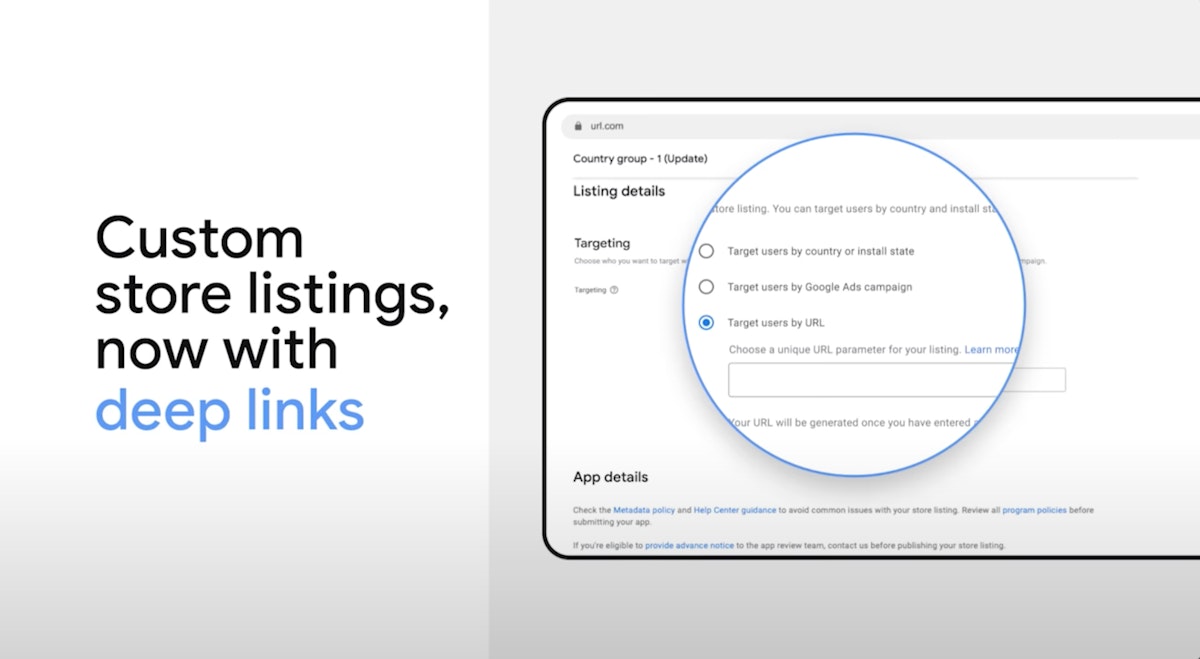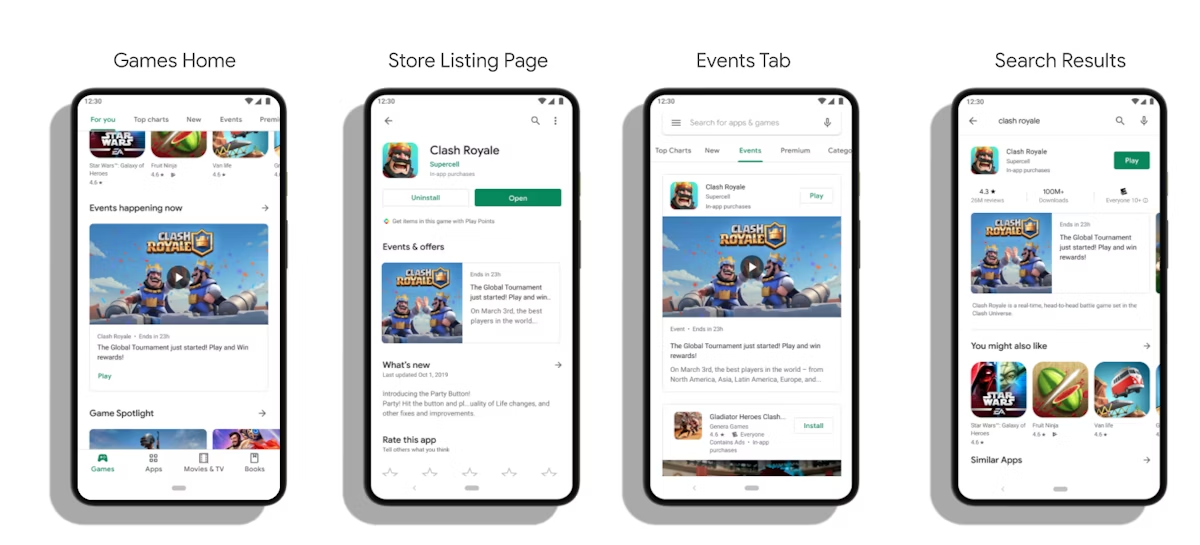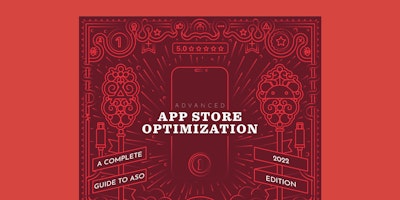
Google Play Announcements: ASO 2.0 is Here!
Last week, Google announced a series of significant updates and new product features for Android developers and publishers during the annual I/O developer conference. Google’s announcements were much anticipated after Apple’s 2021 release of iOS 15 brought important features that help developers better promote their apps on the App Store. This May, Google responded by matching (and even, perhaps, raising) Apple to provide tools to further please app marketers. Read this blog to understand the latest changes and updates arriving on Google Play!
Data safety and app performance features
Google began by announcing the latest features around data safety and user privacy before turning to new tools to help app developers improve app performance. In truth, no major changes were announced regarding data safety, as Google’s timeline for releasing its “privacy sandbox” on Android had already been announced a few months ago.
The only privacy-related announcement that could impact App Store Optimization was the reiteration that developers will have until July 20, 2022, to fill in the necessary information for the upcoming store privacy section which will inform users about the data that may be collected and/or shared by an app. Nevertheless, this section is not expected to have much impact on Play Store listings conversion rates, as it is expected to be placed below the first screen.
.png?auto=format,compress&q=75&w=1200) Turning to features regarding app performance monitoring and improvement, we’ve identified two announcements that may be particularly relevant to ASO practitioners:
Turning to features regarding app performance monitoring and improvement, we’ve identified two announcements that may be particularly relevant to ASO practitioners:
- Android vitals will soon be available at a country level and via the Google Play Developer Reporting API. Though the primary beneficiaries of this tool will be product teams, ASO teams may also benefit from it when investigating changes in their app or keyword rankings.
- More importantly, Google’s in-app update API will let developers inform users when a newer version of their app is available and help them see release notes and download the update without having to leave the app. In this instance, ASO will (hopefully) be able to benefit from improved retention rates following more frequent (and better communicated) app updates.
Update: With a view to raise the bar on technical quality, Google Play updated its core vital metrics with more user-focused metrics that are a better reflection of user experience. Google also introduced a new bad behavior threshold that is evaluated per phone model (e.g. Pixel 6). At launch, this threshold will be set to 8% for both user-perceived crash rate and user-perceived ANR rate. So, if your title exceeds the device bad behavior threshold on any core vital for a given phone model, Google Play may reduce the visibility of your title for users on that phone model. Further, Google requires apps and games to maintain a minimum of 3.0 star ratings to be featured in the top charts from February 2023.
Promotion and engagement tools
Although these initial product announcements should be considered for App Store Optimization, the most important announcements at Google’s I/O conference regarded new tools and feature updates for marketers to improve conversion and user engagement with custom store listings, promotional content, and Google Play billing.
Custom store listings: Going one step further than Apple
Initially introduced in March 2019, custom store listings already allowed app publishers to create alternate Play Store pages for their apps, but would only be segmented by country/region or install state (pre-registration only). Such settings made custom store listings quite limited, as app marketers often looked for more advanced segmentation opportunities; this was especially the case after Apple released iOS 15 custom product pages and allowed marketers to create very tailored store landing pages, accessible via URLs, for their various campaigns.
Learn more about custom store listings and how to use them for ASO
Google has now improved its own system to match Apple’s, with custom store listings now supporting referral traffic by letting developers create custom URLs for any of their custom store listings. Furthermore, with Google now granting each app publisher a maximum of 50 (vs. the previous 5) custom store listings per app and allowing each of them to be localized in multiple languages, adding the possibility to display not only different screenshots and promo videos, but now also to change the Google Play app icon, title, and descriptions, it is fair to say Google has raised the bar in response to Apple’s custom product pages.
In turn, this confirms a fundamental shift now coming to App Store Optimization, as ASO practitioners will now have all the necessary resources to stray away from the old “one page fits all” approach and instead investigate which segmentation methods to leverage and which custom pages to release to maximize performances. On that note, it is also worth noting that Google has now teased the possibility of using custom store listings for Google Ad Campaigns, although we have not yet seen this option in the Play Store console ourselves.

Promotional content: Open beta applications & closed beta insights
Another essential marketing tool Google promoted was promotional content (previously LiveOps). Initially made available to only a select group of developers during the first phase of the closed beta, promotional content allowed Android devs to promote in-app activities and content directly on the Play Store. Google has now announced that promotional content is entering an open beta phase, with all developers being given the possibility to apply to the program through the following form.

As part of this announcement, Google shared that apps that had run promotional content during the closed beta had registered an average of 5% more active users and 4% higher revenue when compared with equivalent apps that did not. Another benefit of promotional content is “offer,” which allows developers to grant users discounts, deals, or free rewards as part of a promotional content, a feature that is currently lacking in Apple’s in-app events.
Promotional content could potentially give an even bigger return on Android than on iOS, due to the more significant role of featurings for most apps on the Play Store than on the App Store, especially if rumors of an upcoming “events” tab in the Play Store turn out to be true.
Google Play Commerce: Additional feature to facilitate monetization
Last but not least, Google unveiled some improvements to its Play Commerce system through which developers may be able to monetize their apps.
After having expanded its payment method library to more than 300 local payment methods in 70 countries over the last 12 months, Google added several eWallet payment methods that may be very popular in South East Asia and other regions of the world, and is now expanding pricing options with ultra-low price points that decrease the minimum price for a purchase to the equivalent of 5 US cents in any market. This price adjustment is not only meant to help developers adjust prices to local purchasing powers but also to be able to run locally relevant sales and promotions and support micro-transactions, such as tipping.
Google Play is also offering app developers relying on subscription-based revenue models the possibility to configure multiple base plans and offers: Each base plan in a subscription will define a different billing period and renewal type, thus allowing developers to offer monthly and yearly auto-renewing plans (and also pre-paid plans) for any duration. Each base plan will also be allowed multiple offers to optimize monetization, such as free trials or discounts for upgrades to higher plans.
Finally, Google has updated its in-app messaging API to allow developers to display a message to users whose payments have been declined, thus helping to prevent technical churn when users lose access to certain app features after forgetting to update their purchase information. Such a simple step can be key to maintaining revenues, as Google shared that early users experimenting with the feature saw their subscription recovery rate double.
Conclusion
To summarize, the recent announcements on Google Play not only appear to have been a direct answer to most of Apple’s iOS 15 features, but also confirm a fundamental shift in App Store Optimization. It implies moving away from a single focus on new user acquisition reliant on a one-page-for-all approach to now offering significant tools to facilitate user segmentation, retention, and monetization.






 Justin Duckers
Justin Duckers

 Suleika Vanmaele
Suleika Vanmaele

 Anthony Ansuncion
Anthony Ansuncion